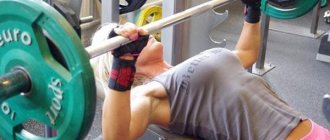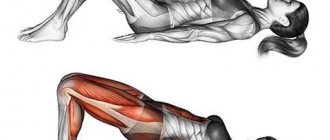Greetings, dear readers! If your goal is not only a beautiful body, but also a healthy back, as well as a strong spine, then the bridge from a lying position is an exercise that simply must be included in your list of activities.
If you agree, be sure to read this material further! From it you will learn what a gymnastic bridge is, in fact, why it needs to be done. And how to do this bridge variation correctly. How should you prepare for it so as not to harm yourself? And also get information about the benefits it will bring to your body and your figure.
What is a gymnastic bridge?
The bridge from a prone position is a basic exercise in gymnastics. The student stands in such a bridge, having previously assumed a lying position on a hard surface.
Its main feature is that during its execution many muscles actively work. A large number of joints are also involved. The technique of this activity is not overly complicated. However, not every beginner will be able to perform the bridge correctly, much less hold this unusual position for 5 seconds.
However, any sports enthusiast who has read this material will be able to master the bridge from a prone position at any age. It is only important to follow all the recommendations and regularly devote some time to preparatory exercises. No special place, no trainer, no special equipment is required for activity.
Who is contraindicated to perform a gluteal bridge?
Even the most seemingly harmless exercise can lead to unpleasant sensations or, even worse, injuries. In order to avoid them, you need to immediately find out whether you can do a shoulder bridge or not. It is contraindicated for people who:
- gastroesophageal reflux - reverse movement of stomach contents into the esophagus;
- acute period of spinal disease: inflammation, hernia;
- problems in the cervical spine.
Photo: istockphoto.com
In the latter case, it is permissible not to cross the gluteal bridge. But you need to correctly adjust the technique of its implementation.
Denis:
If there are problems in the cervical region, place a rolled up towel or a small cushion under it. Or we use the “lying on an elevated” option: on a sofa, chair, armchair, bench. And we perform the exercise so that the head relative to the body is in a natural position, without strong bends.
Should I wear a sports bra for home workouts? Mammologist's opinion
Benefits of bridge exercise
If you do this type of bridge, dear readers, you will get a lot of advantages. Firstly, you can simply make your muscles stronger and stronger. Secondly, develop flexibility. Thirdly, improve your coordination of movements. Finally, make your figure attractive and harmonious.
Why else do you need the bridge exercise?
The benefits of this type of bridge are enormous. It is expressed in the following main points:
- muscles are worked extremely efficiently and deeply;
- the muscles of the thighs, back, gluteal, and lumbar are involved simultaneously;
- the spine is safely stretched and decompressed;
- the mobility of the practitioner in the hips and hip area increases;
- core muscles become stronger
- hands and forearms are strengthened;
- posture improves;
- pelvic rotation is corrected;
- the abs are strengthened;
- pain in the back and lumbar area goes away;
- blood flow is activated in the tissues that surround the intervertebral cartilage;
- blood flow to the brain is also activated, thereby improving its functioning
- increases tone and vitality;
- the mobility of the lumbar zone increases;
- increases life expectancy.
How is a bridge useful for the spine?
In short, the prone bridge is an exercise that signals the condition of your back. If you are not able to stand on such a bridge within 5 seconds, then you have neglected your back and your health in general.
Therefore, back pain is only a matter of time. The saying here is appropriate, if we don't use our spine, we lose it. More precisely, he quickly loses mobility.
A bridge from a lying position helps to effectively develop the mobility of our spine and prevents the critical processes of healing of joint spaces between the vertebrae and pinching of nerve endings.
Pinched nerves lead to terrible pain. Unfortunately, such processes are not always reversible. Therefore, you need to be proactive!
There is a whole X-ray diagnosis, the condition of the spine based on the size of the gaps between the vertebrae. A friend of mine had one made like this. At 45 years old, he could quite easily do a gymnastic bridge from a supine position. And what do you think? To the surprise of the doctors, despite the age, the images revealed only a slight (within normal limits) narrowing of the distance between the vertebrae in the thoracic region.
In fact, narrowed intervertebral spaces are a dangerous signal. The next stage is manifested in the overgrowing of these cracks, calcium deposits and the final loss of mobility.
And there it is not far from disability.
Benefits of elbow bridges
The benefits of elbow bridges are undeniable. An elbow bridge stimulates the thyroid and pituitary glands. Due to the opening of the chest and active stretching of the upper chest, it increases the volume of the lungs, therefore it is a favorable pose for those who suffer from lung diseases, in particular asthma. The abdominal organs are also stimulated, thereby improving digestion and metabolism.
Performing the pose has a beneficial effect on the condition of the heart. It is also therapeutic for people suffering from hypertension. It helps relieve fatigue and stress. Thanks to this exercise, you can even get rid of a mild headache (it is worth noting that a headache is a contraindication to performing the bridge, so if you suffer from severe migraines, then it is better to avoid performing the asana).
As with any backbend, the sympathetic nervous system is activated, which awakens activity, fills with energy and gives a charge of vivacity. Therefore, the elbow bridge is best performed in the morning asana complex.
The elbow bridge pose is considered a slight inversion and has all the positive effects that are usually characteristic of inverted poses: it has a rejuvenating effect on the body, improves blood circulation, promotes spinal traction, and helps prevent cardiovascular diseases.
Contraindications
Even such an accessible and safe activity as a bridge from a lying position has contraindications. The main contraindication is, of course, spinal injuries, as well as other types of serious injuries that exclude significant stress in order to avoid harm to the body.
We provide additional contraindications for you below:
- pregnancy;
- postoperative period;
- vertebral protrusions, as well as hernias (in this case there are other exercises);
- chronic diseases in acute form;
- osteochondrosis accompanied by pain (allowed with delicate execution);
- arthrosis, arthritis, other serious problems with bones, joints (allowed, without forcing and with delicate execution, but not during an exacerbation).
How to stand on a bridge from a supine position?
Here we describe for you the main stages of how to do a bridge from a lying position:
- Lie down on a comfortable, hard surface.
- Bend your legs at the knees, place your feet firmly, close to the pelvis, fix this position.
- Place your hands behind your head (at ear level), rest your palms securely on the surface, with your fingers facing you. Switch the emphasis completely to the top.
- Now, leaning on your palms and feet, lift your pelvis up, at the same time lift your shoulder blades and head off the floor, resting on your palms. Your task is to rise completely, forming something like an arch. That is, you don’t just move up, but bend in the lower back, and your stomach becomes the highest point.
- Hold for a few seconds.
Carefully return to the starting position. To do this, start lowering from the shoulder blade area, keeping tension in your hands. Your buttocks should be the last thing to hit the floor. For a more complete understanding, watch the video with this exercise.
Additional Activity Variation
For beginners, it is recommended to start with the bridge option from a lying position, when the head does not come off the floor.
In other words, in the final position you lean on your arms and head with emphasis on your feet.
This bridge is lower than the basic version and is easier to make. In any case, be careful with your neck.
You can also make your bridge even more effective. To do this, do not just one exercise, but a series of several. At the same time, at the lowest point, do not lower your pelvis completely onto the mat; stop it a few centimeters from the floor. This will increase the efficiency of the bridge and make the activity more difficult.
This variation of the bridge is not suitable for beginners, but rather for experienced practitioners. Beginners should ideally first master performing the bridge from a prone position, in its basic form with support, which is described above.
Execution technique
Before we talk about how to stand on the bridge, let's determine what exactly the body position should be in this pose:
- When performing a bridge, your back should be arched. A bridge with a straight back, made at the expense of the limbs, is incorrect.
- The buttocks should be higher than the head and shoulders.
- The limbs should be as straight as possible, the hands should be on the palms, and the legs should be on the feet. The distance between the palms (as well as between the feet) should be equal to the width of the shoulders. Achieving this level of performance is not easy, but we are now talking about the ideal option.
- Breathing should be free, without delay.
In order to learn how to perform a bridge correctly, you need to consistently practice all the exercises leading up to it. Let's list these exercises, and then give a description of each of them. They are arranged in order of increasing difficulty:
- Bridge with emphasis on the shoulders.
- Straight bridge (you may have heard of this exercise called the “reverse plank”).
- Bridge from the bench.
- Half bridge.
- Classic full version.
Actually, you can stop at the fifth point, however, there is no limit to perfection. Therefore, we move further towards complexity:
- Bridge along the wall down and up.
- Entering the bridge from a standing position.
- Lifting from the bridge to a standing position.
Bridge exercise and common mistakes
Even experienced trainees make mistakes, let alone “dummies.”
Therefore, when performing a bridge and getting into it from a lying position, try not to commit such common violations:
- bend your back in an arc, round it, do not lift using only your legs and arms;
- make sure that your buttocks are higher than your shoulders when you lift;
- do not bring your palms and feet close together; the distance between them should ideally be equal to the width of your shoulders;
- do not hold your breath, breathe freely and smoothly;
- do not force things, start gradually and go through all the main stages of the exercise;
- do not leave your limbs bent too much, try to straighten them as you rise. Also gradually move your feet closer and closer to your hands, making your bridge more vertical.
How to prepare properly?
In order to confidently, without risks and difficulties, and correctly get into the bridge from a lying position, it is highly advisable to prepare for this activity. This preparation is especially relevant for you if you are a beginner and have not previously strengthened your back, arms, lower back, or various muscles. The following training exercises will serve as excellent preparation for you and will help you develop your spine, strengthen and stretch the necessary muscles.
Bridge exercise and lead-in exercises
- The gluteal bridge is the first and simple exercise that you should pay attention to and read in detail at the link.
- Sphinx. Activity improves spinal flexibility. Lie in a “stomach” position, raising your upper torso, focusing on your forearms (elbows). Pull your toes back. Your stomach should remain on the floor. Pull your shoulders back as if you are trying to connect your shoulder blades. There is no need to throw your head back. Stay in this position for about 40 seconds, then slowly lower down and rest for a couple of seconds. Repeat 3 times. Try to work the thoracic part of the vertebrae in this position with maximum deflection.
- Cobra. This is a slightly more complex variation of the previous activity. Lie down in the same way as in the previous description. But lean on your palms. And due to this change, strengthen the arch in the back, increasing the amplitude of the arch. Hold for at least 40 seconds, then slowly and carefully lower yourself down, helping yourself with your hands. Do 3 full Cobra sets. Read more here.
- Box. Activity perfectly strengthens the spine, gluteal muscles, and arms. Lie down in the same way on your stomach. Place your palms on the floor. Raise your body by bending backwards. At the same time, bend your legs at the knees. Reach your head towards your socks as if you are trying to reach them with the top of your head. At the same time, do not tilt your neck too far back. Make the movement with a deflection in the thoracic and lumbar regions. Stay in this “box” for 20, or better yet, 30 seconds. Then slowly lower your arms and legs. Repeat 3 times.
- Superman or boat. Increases spinal flexibility and strengthens the spinal muscles. Lie on your stomach, stretch your arms straight forward. Raise, moving smoothly, the lower and upper parts of the body up, but not high. At the same time, lift your hips and chest off the floor. Try not to bend your knees. Stretch your arms forward in a straight position. Stay elevated for 20 or 30 seconds, then slowly lower down. Repeat 3 or 4 times.
- The camel exercise is an inverted bridge.
- To strengthen your hands, downward-facing dog and regular push-ups are good.
To prepare for the bridge, do these activities for 2-3 weeks, every other day. Only after such preparation proceed to the main task.
How to do an elbow bridge: preparation
Before we begin mastering the Elbow Bridge Pose, let’s look at what preparatory exercises can be done to prepare the spine for this asana, and what exercises should be included in the warm-up complex to warm up the back muscles involved in performing the asana.
Exercises that do not create a strong load on the spine prepare well for performing this asana. For example, a series of shallow backbends can help strengthen the back muscles and prepare the spine: Stretch Pose with Raised Arms (Urdhva Hastasana), Grasshopper Pose (Salabhasana), Bridge Pose (Setu Bandha Sarvangasana), Camel Pose (Ushtrasana), Bow Pose (Dhanurasana). ), Cobra Pose (Bhujangasana), Upward-Facing Dog Pose (Urdhva Mukha Svanasana).
Exercises to develop arm flexibility and shoulder joint mobility are suitable as a warm-up. The most effective exercise for warming up the back muscles and preparing for backbends is Marjariasana, or Cat Pose. You can perform the “cat” in the classic version, and also do crunches - Parivrita Marjariasana to warm up the lumbar region and oblique abdominal muscles.
Marjariasana
An excellent preparation for the muscles and spine for performing the asana is the “wave” of Cat Pose: sliding the chest forward along the mat and stretching upward on the hands (Upward-Facing Dog Pose); in the opposite direction, also carry out a sliding movement along the mat backwards; Finally, lower your pelvis onto your heels and your chest onto your hips (Child’s Pose). Repeat the “wave” several times.
Brief conclusion
The bridge from a lying position is an indicator of the health of our back, as well as the most useful and effective activity. Reviews from those who included it in their sports “menu” confirm this! And now, dear readers, you know exactly how to do it. And also - how to prepare for it in order to get maximum benefits and no risks. Practice following our instructions. Then you will be able to reverse the degenerative changes in the cartilage of the spine and have a healthy back.
In addition to the fact that you will not experience acute pain, as a bonus you will receive strong muscles of the spinal column, a beautiful figure and a completely different vitality, regardless of age.
Thank you for reading this article. We will be grateful if you like it and share it with your friends via social networks. The bridge we looked at today is a prelude to a real gymnastic bridge from a standing position. And more about this in the next article.
Be healthy, dear friends. See you soon on the street of new opportunities!
About the benefits of the bridge and how often it should be done
The gymnastic bridge is one of the simplest exercises and stances. Despite this fact, the benefits of this element are considerable. The following positive changes occur in the human body.
- The muscles that fix the spinal column become stronger and stronger. With the help of these muscles, the back bends and extends.
- In addition to working out many of the back muscles, the muscle groups of the shoulder girdle, arms, buttocks and legs are also involved.
- The flexibility of the spine and back muscles increases.
- The abdominal muscles are stretched.
- The wear resistance of the vertebral discs increases, which occurs due to improved blood circulation in the tissues.











